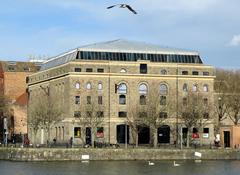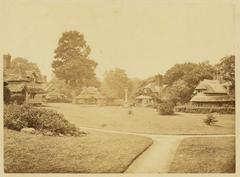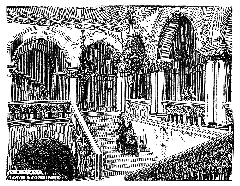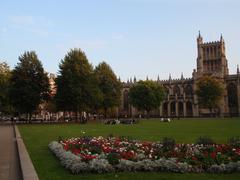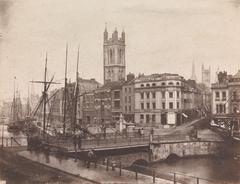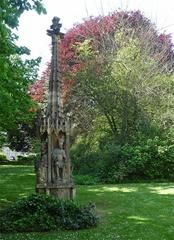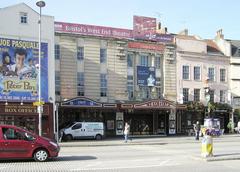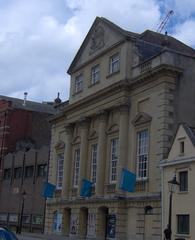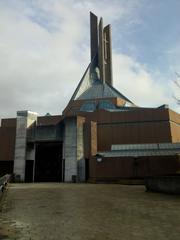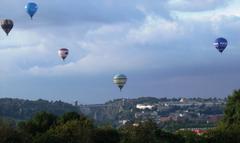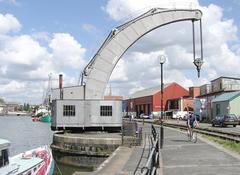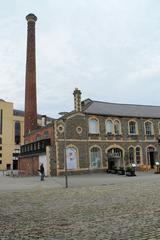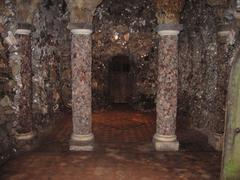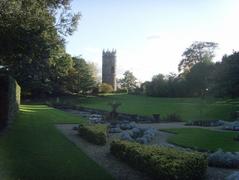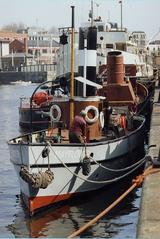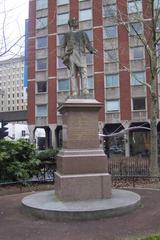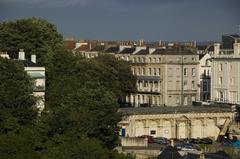The Downs Bristol: Visiting Hours, Tickets, and Guide to Historical Sites
Date: 04/07/2025
Introduction
The Downs in Bristol, encompassing both Clifton Down and Durdham Down, are among the city’s most iconic and beloved open spaces. Spanning over 400 acres, these historic commons offer a harmonious blend of natural beauty, deep-rooted history, and dynamic community life. Open year-round with free public access, The Downs invite visitors to enjoy everything from tranquil walks and picnics to vibrant festivals and conservation initiatives that celebrate Bristol’s heritage and ecological diversity.
This comprehensive guide covers essential information for visiting The Downs, including opening hours, ticket details, accessibility, history, conservation, events, travel tips, and nearby attractions, ensuring every visitor can make the most of this exceptional Bristol landmark (Bristol City Council; Merchant Venturers).
Essential Visitor Information
Opening Hours & Entry
- The Downs: Open 24 hours a day, year-round.
- Entry: Free for all visitors; no tickets or reservations required.
Getting There & Accessibility
- Location: North of Bristol city centre, accessible from Clifton, Redland, and Westbury Park.
- Public Transport: Multiple bus routes serve the area; nearest stops include Stoke Road, Pembroke Road, Whiteladies Road, and Clifton Village.
- Cycling: Bike racks available; cycling encouraged.
- Parking: Limited free and pay-and-display parking along Circular Road and Stoke Road. Parking is tight during weekends and major events—public transport or cycling recommended.
- Accessibility: Paved paths and accessible parking; suitable for wheelchairs and strollers. Some grassy areas may be uneven.
- Dogs: Welcome but must be kept on a lead in sensitive areas to protect wildlife.
Facilities
- Toilets: Public toilets are located near the water tower.
- Refreshments: Mobile food vendors operate during weekends and events; nearby Clifton Village offers a variety of cafés and restaurants.
Overview & Historical Significance
Common Land Traditions
The Downs’ roots trace back to medieval times when they served as common grazing land for local residents. This tradition of communal land use is preserved in today’s management and is commemorated by periodic ceremonial sheep grazing events (Bristol City Council).
The 1861 Downs Act & Stewardship
Ownership of The Downs is shared between the Society of Merchant Venturers (Clifton Down) and Bristol City Council (Durdham Down). The pivotal 1861 Downs Act protected the area from urban development, mandating its preservation “for the benefit of the people of Bristol.” The Downs Committee, comprising representatives from both owners, oversees management and ensures the land remains publicly accessible (Merchant Venturers).
Ceremonial Grazing & Tradition
Thirteen local groups, including the University of Bristol Botanic Gardens and Badminton School, retain the ancient right to graze sheep. Although regular grazing ended in 1925, the tradition is honored every five years with a ceremonial event that includes heritage breed sheep and educational activities (University of Bristol News; Bristol Post).
Recreation, Wildlife, and Conservation
Natural Beauty & Biodiversity
The Downs are recognized as a Site of Nature Conservation Interest, supporting over 14 hectares of limestone grassland, rare wildflowers (like bee orchids), and wildlife such as peregrine falcons and the silky wave moth (Avon Gorge & Downs Wildlife Project). Conservation grazing and community stewardship are key to maintaining this diverse ecosystem.
Activities
- Walking, Running, & Cycling: Extensive networks of paths and trails.
- Sports: Football, rugby, and cricket pitches are regularly used, especially by local leagues.
- Picnics & Informal Play: Open spaces are ideal for family gatherings, kite flying, and outdoor games.
- Wildlife Watching: Birdlife and wildflower meadows attract nature enthusiasts.
Landmarks & Historical Sites
Clifton Suspension Bridge Views
The southern edge of Clifton Down offers spectacular views of the Clifton Suspension Bridge—one of Bristol’s most photographed landmarks, designed by Isambard Kingdom Brunel (Lonely Planet).
Clifton Observatory & Camera Obscura
This 18th-century windmill-turned-observatory houses a rare working camera obscura. Visitors can enjoy panoramic views and access the Giant’s Cave via a tunnel, emerging halfway down the cliff for a dramatic perspective on the Avon Gorge (Adventures of Alice; Wide World Trips).
- Opening Hours: Typically 10:00 AM to 5:00 PM (extended in summer).
- Tickets: Required for entry to the observatory and cave.
The Giant’s Cave
This cave is steeped in local folklore and history, with archaeological evidence of use as a chapel dating back to the 4th century. The viewing platform provides one of Bristol’s most exhilarating overlooks (Wide World Trips).
Other Features
- Downs Water Tower: A Victorian landmark near Durdham Down’s center.
- Roman Road & Clifton Down Camp: Ancient monuments highlighting the area’s long history.
- Boundary Stones & Memorials: Marking the division between Clifton and Durdham Down and commemorating notable events and individuals.
Festivals & Major Events
Forwards Festival
A major music festival held in August, Forwards Festival brings together international headliners, local artists, and discussions on social change through the “Forwards Thinking” initiative (Forwards Festival).
Feast On Food Festival
A July celebration of Bristol’s culinary scene, featuring pop-ups, markets, cooking demonstrations, and family activities (Feast On).
Funderworld
The UK’s only mobile theme park, Funderworld appears each spring with over 50 rides, family attractions, and daily live entertainment (Funderworld).
Bristol International Balloon Fiesta
Although primarily held at Ashton Court, The Downs provide a perfect vantage point for mass hot air balloon ascents during this world-famous August event (Visit Bristol).
Conservation, Education, & Community
Groups such as Friends of The Downs and the Avon Gorge & Downs Wildlife Project are deeply involved in conservation, educational walks, and ecological advocacy (Avon Gorge & Downs Wildlife Project). Interpretive trails, signboards, and guided tours introduce visitors to the Downs’ geology, biodiversity, and social history.
Practical Tips for Your Visit
- Check event schedules before visiting, especially during major festivals.
- Dress for the weather: The Downs can be windy and exposed.
- Respect wildlife: Keep dogs under control and stay on marked paths in sensitive areas.
- Use bins or take litter home to help maintain the area’s beauty.
- Stay safe: The Downs are generally safe, but take usual precautions after dark.
FAQs
Q: Are The Downs open all year?
A: Yes, open 24/7.
Q: Is there an entrance fee?
A: No, free for all. Some attractions/events may require tickets.
Q: Are dogs allowed?
A: Yes, but keep them on a lead in protected areas.
Q: Is the area accessible for wheelchairs and prams?
A: Yes, paved paths and accessible parking are available.
Q: What’s the best way to get there?
A: Public transport or cycling is recommended due to limited parking.
Q: Are there guided tours?
A: Yes, check with local organizations for schedules.
Enhance Your Visit
- Download the Audiala app for interactive tours, event updates, and local tips.
- Follow Bristol City Council and local tourism social channels for the latest news.
- Explore nearby: Clifton Suspension Bridge, Bristol Zoo Gardens, Avon Gorge, and Clifton Village.
References
- Bristol City Council: The Downs
- Society of Merchant Venturers: How The Downs Came to Be
- Adventures of Alice: Places to Visit in Bristol
- Wide World Trips: Things to Do in Bristol UK
- University of Bristol News: Sheep Grazing 2025
- Avon Gorge & Downs Wildlife Project: Visiting Us
- Bristol Post: Sheep Spinning Wheels Return Downs
- Bristol Pride: Pride Day
- Total Bristol: Top Annual Events in Bristol
- Visit Bristol: Festivals
- Forwards Festival
- Feast On Food Festival
- Funderworld
- Lonely Planet: The Downs
- GPSmyCity: The Downs
